22 March 2023: Human Study
A Questionnaire-Based Study to Compare the Psychological Effects of 6 Weeks of Exercise in 123 Chinese College Students
Mei Xue Wei1ABCDEG, Zhen Liu2ABCFG*DOI: 10.12659/MSMBR.939096
Med Sci Monit Basic Res 2023; 29:e939096
Abstract
BACKGROUND: The aim of this study was to explore the mechanisms underlying the association between exercise intervention and mental health, and our questionnaire-based study aimed to compare the psychological effects of 6 weeks of exercise among 123 Chinese university students.
MATERIAL AND METHODS: A total of 123 college students were randomly divided into the experimental group (80 patients) and the control group (43 patients). The experimental group participated in a 6-week exercise intervention, and the control group received no intervention. Questionnaires were used to study emotion regulation and mental health.
RESULTS: The exercise intervention has a significant effect on reducing the anxiety and depression levels of college students [F(1,122)=10.83, p<0.01, F(1,122)=9.63, p<0.01]. Male students were superior to female students in perceived self-efficacy in managing despondency/distress [F(1,122)=26.77, p<0.01] and emotion suppression [F(1,122)=6.13, p<0.05]. The anxiety factors of female students [F(1,122)=10.06, p<0.05] and depression factors [F(1,122)=9.86, p<0.01] were significantly higher than in male students.
CONCLUSIONS: Our study shows that a 6-week exercise intervention significantly improved the mental health of college students. Aiming to determine the mechanism underlying the influence of exercise intervention on college students’ mental health, this paper proposes a new structural relationship. Emotion regulation self-efficacy and emotion regulation strategy play a mediating role in the relationship between physical education and mental health. Physical education teachers in colleges and universities should actively carry out physical education, make full use of the distinctive characteristics and advantages of physical education, and purposefully and systematically guide college students to actively participate in physical exercise.
Keywords: Stress, Psychological, Mental Health, Exercise, Students, Humans, Anxiety, Surveys and Questionnaires
Background
In sports, university students can freely release their inner stress, unhappiness, bitterness, and other negative emotions by choosing a variety of sports, and feel the joy of exercise through the sense of achievement and physical exhaustion afterwards. Many studies have shown that physical exercise have an important impact on mental health [1–10], while the theoretical basis for research related to physical exercise and mental health is different, and the conclusions and paths are different. Several studies have highlighted the direct positive impact that physical activity can have on mental health, keeping people in a good frame of mind and in a positive mood. McInman and Berger [1] measured subjects after physical exercise, showing that their levels of state anxiety, depression, stress, and psychological disorders were significantly reduced, and their energy and enjoyment were significantly improved. Other studies emphasize that physical exercise can enhance regulatory emotional self-efficacy (RES), and boosts self-confidence. Downs and Strachan [2] showed that participation in high school physical activity can help improve RES and thus has a positive impact on physical activity levels. Some studies have focused on the effect of people’s emotion regulation self-efficacy on their mental health, as manifested by a positive mindset towards coping with adversity. Lightsey et al [3] have shown that RES is an important indicator of whether an individuals can effectively manage their emotional state. Its role is to relieve tension, maintain emotional regulation, help regulate emotional impulses, and promote mental health. In addition, some studies focused on the importance of emotion regulation strategy (ERS) for mental health. Garnefski and Kraaij [4] conducted an in-depth study of cognitive ERS and depression, anxiety, and other mental health variables, and concluded that cognitive ERS can effectively predict the degree of anxiety and depression of individuals. In the context of the COVID-19 pandemic, physical exercise has a significant impact on the prevention and alleviation of depression and can effectively enhance the positive attitude of university students towards life [5].
In summary, existing research shows the relationship between physical exercise and mental health, physical exercise, and Emotion Regulation Strategy (ERS), ERS and mental health, ERS and mental health from their respective perspectives and approaches. However, the relationship between the various factors, the role of each factor, the size of the effect, and the overall effect are difficult to explain under the separation of the research environment system.
In the current study, we aimed to explore whether a relationship exists between physical exercise and mental health among university students. Based on literature analysis, this study incorporates 2 emotional variables – Regulatory Emotional Self-Efficacy (RES) and Emotion Regulation Strategy (ERS) – into the research framework based on the emotional theory of physical exercise. A structural model between physical exercise, RES, ERS, and mental health was constructed (Figure 1). The model has important guiding significance for understanding how students’ physical exercise affects mental health and improves their mental health. Therefore, this questionnaire-based study aimed to compare the psychological effects of 6 weeks of exercise in 123 Chinese college students.
Material and Methods
PARTICIPANTS:
In this study, 123 college students were selected, including 56 male students and 67 female students. The age ranged from 19 to 23 years old, with an average age of 21.06 years (SD=2.36). No regular exercise was performed within 2 months; participants with physiological status suitable for participating in the intensity of the intervention were selected through physical fitness scores. All the participants signed a test agreement to comply with the test requirements.
We randomly divided 123 people into the experimental group (80 people, including 38 male students and 42 female students) and the control group (43 persons, including 18 male students and 25 female students). The experimental group underwent a 6-week exercise intervention, and the control group studied and lived at the same time, and promised not to participate in regular physical exercise activities during this period. All subjects in this study were recruited based on voluntary and informed consent, and the rights and privacy of the subjects were protected to the maximum extent possible, and there were no conflicts of interest in the content or results of the study.
EXPERIMENTAL CONTROL:
Participants who were physiologically fit to participate in the intensity of this intervention were first screened by their physical fitness scores. All subjects refrained from participating in regular exercise for 2 months and signed a trial protocol committing them to comply with the trial requirements.
RESEARCH HYPOTHESIS:
Physical activity can indirectly influence the level of psychological well-being of university students by improving both emotion regulation self-efficacy and emotion regulation strategies.
EXERCISE INTERVENTION:
The exercise intervention was mainly based on aerobic running and team exercise and the implementation scheme is shown in Table 1. The monitoring of aerobic exercise was strictly controlled from 3 aspects: exercise intensity, time, and frequency (Table 2). The exercise intensity was controlled at medium intensity, ie (220-age)×(60~69%); the exercise time was 60 min/times, wherein aerobic running for 30 min and teamwork exercise for 30 min. The exercise frequency was 3 times per week.
REGULATORY EMOTIONAL SELF-EFFICACY:
The Regulatory Emotional Self-Efficacy (RES) Scale compiled by Caprara et al [11] was used. The revised test-retest reliability is 0.825, p<0.01, the scale Cronbach’s α=0.841, and the sub-factor α is 0.807–0.829. Wherein, the α coefficient of perceived self-efficacy in expressing positive affect (POS)=0.829; the α coefficient of perceived self-efficacy in managing despondency/distress (DES)=0.825; the α coefficient of perceived self-efficacy in managing anger/irritation (ANG)=0.807. The load of each factor was between 0.567 and 0.835, and the structural indicators were goodness-of-fit index (GFI)=0.931, adjusted goodness-of-fit index (AGFI)=0.914, incremental fit indices (IFI)=0.926, normed/non-normed fit index (TLI)=0.907, comparative fit index (CFI)=0.938, root mean square error of approximation (RMSEA)=0.080, and all indicators met the psychometric indicators.
EMOTION REGULATION QUESTIONNAIRE:
The Emotional Regulation Questionnaire (ERQ) prepared by Gross et al [12] was used. The questionnaire is mainly used to assess the difference in the use of 2 Emotion Regulation Strategy (ERS): cognitive reappraisal and expression suppression in an individual’s daily life. The revised test-retest reliability was 0.90, p<0.01, the α coefficient of all items was 0.742, the cognitive reappraisal α coefficient was 0.771, and the expression suppression α coefficient was 0.632. The load of each project factor was between 0.544 and 0.780, and all indicators were in line with psychometric indicators.
SYMPTOM CHECKLIST 90 (SCL-90):
The SCL-90 scale compiled by Derogatis [13] was used. The scale includes 90 items covering a wide range of psychological symptomologies such as thinking, emotions, behaviors, relationships, and lifestyle habits. The assessment time can be assessed for a specific time, usually for a week. The assessment method is divided into 5 grades (from 0 to 4), with 0=never, 1=light, 2=moderate, 3=serious, and 4=serious. In view of the general mental health problems of college students, which are mainly reflected in anxiety and depression, the study mainly used anxiety and depression as indicators of mental health.
STATISTICAL ANALYSIS:
The study used SPSS 20.0 and Amos 18.0 statistical software to conduct statistical and analysis of the research data.
Results
THE HOMOGENEITY OF REGULATORY EMOTIONAL SELF-EFFICACY (RES), EMOTIONAL REGULATION QUESTIONNAIRE (ERQ), AND MENTAL HEALTH BETWEEN EXPERIMENTAL GROUP AND CONTROL GROUP BEFORE EXERCISE INTERVENTION:
Before the exercise intervention, RES (Expressing Positive Affect (POS), Managing Despondency/Distress (DES), Managing Anger/Irritation (ANG), ERQ (Cognitive Reappraisal and Expression Suppression), and Mental Health (Anxiety Factor and Depression Factor) were tested in the experimental group and the control group, and the test results were subjected to independent sample
EFFECTS OF EXERCISE INTERVENTION ON COLLEGE STUDENTS’ RES, ERQ, AND MENTAL HEALTH:
Repeated measures analysis of variance was performed (time: pretest, posttest)×2 (group: experimental group, control group). For the RES (POS, DES, and ANG), ERQ (Cognitive Reappraisal and Expression Suppression), and Mental Health (Anxiety Factor and Depression Factor) of college students before and after exercise intervention, descriptive statistics (M±SD) were performed, as shown in Table 3.
The main effect of exercise intervention was not significant in POS and expression suppression,
The main effects of exercise intervention were significant in DES, ANG, and Cognitive Reappraisal,
After the exercise intervention, the anxiety and depression levels of college students were significantly lower than before exercise the intervention,
DES [
MODEL TEST OF INTRINSIC MECHANISM OF EXERCISE INTERVENTION AND MENTAL HEALTH:
Based on the existing research and the assumptions of this study, the results of the structural equation test model are shown in Table 4.
The results of goodness-of-fit index (GFI), adjusted goodness-of-fit index (AGFI), incremental fit indices (IFI), normed/non-normed fit index (TLI), and comparative fit index (CFI) were all greater than 0.90, indicating that the model fits well with the data. Moreover, the root means square error of approximation (RMSEA) (0.08) of this model follows the test index of 0.05< RMSEA <0.08. The specific fit is shown in Figure 2.
Discussion
The present study found no significant differences in positive regulation and expressive inhibition, but there were significant differences in frustration and distress regulation, anger and anger regulation, and cognitive reappraisal, in line with the findings of Mcinman et al [1,2]. A partial correlation analysis with “gender” as a control variable showed that physical activity was correlated with mental health, with males having higher levels of frustration and distress regulation and expression inhibition than females. Anxiety and depression factors were higher in females than in males. According to social psychology, consciousness is a mental disposition, a state of readiness for behavior, and behavior is an outgrowth of consciousness, a specific response to an object expressed under the influence of an individual’s consciousness [14]. The differences in the mental fields [15] of male and female students cause differences in the way male and female students approach physical exercise behavior, which in turn affects mental health status. It is therefore particularly important that university students are required to engage in weekly physical activity.
Analysis of variance showed that 6-week exercise intervention significantly improved RES, ERQ, and mental health among college students, which is consistent with previous studies [1,6,7,13]. Physical exercise has a direct impact on mental health and can also have an indirect impact on mental health through RES and ERQ.
In-depth analysis shows that the sub-variables contribute differently to each factor in the overall framework. For the 3 elements that constitute RES, the DES is the largest (0.88), followed by the ANG (0.71) and the POS (0.21). It shows that physical exercise has a greater impact on the efficacy of controlling negative emotions, while the impact on the control of positive emotions is relatively small. For ERQ, physical exercise had a positively correlated effect on ERQ (0.39), with cognitive reappraisal (0.92) contributing more than expression suppression (0.16).
Overall analysis showed that physical exercise, RES, and ERQ were negatively correlated with mental health (−0.19, −0.22, −0.24). The higher the score of the 3 factors, the lower the anxiety and depression levels. The contribution levels of anxiety factor and depression factor were roughly the same (0.88, 0.93). The anxiety factors of female students and depression factors are significantly higher than male students. Female students should receive extra care during physical exercise.
In short, physical exercise, DES in RES, and Cognitive in Reappraisal ERQ have a greater impact on mental health, indicating that exercise, efficacy, and strategy are important variables to effectively improve mental health [16]. Therefore, in physical exercise, more emphasis should be placed on the improvement of RES and the cultivation of ERQ. This is an important way to improve the mental health benefits of physical exercise.
Analysis of the results of the exercise intervention shows that physical exercise plays a very special role in maintaining the mental health of college students. Physical education teachers in colleges and universities should actively carry out physical education, make full use of the distinctive characteristics and advantages of physical education, and purposefully and systematically guide college students to actively participate in physical exercise. While encouraging college students to strengthen their physique, they pay attention to active mental health education, improve students’ bad behaviors, fully demonstrate their athletic ability, and improve their psychological qualities, ultimately promoting their overall physical and mental health.
This study has some limitations: (1) the small number of people in the random sample may have influenced our results; (2) the exercise intervention was homogeneous, which may have led to greater heterogeneity between studies; and (3) too few indicators were analyzed, resulting in the need for further research to generalize their exercise intervention.
Conclusions
Our research shows that the 6-week exercise intervention significantly improved the emotional self-efficacy scale (RES) and emotional adjustment questionnaire (ERQ) functions of college students and significantly improved their mental health level. Physical exercise can directly improve mental health and can affect mental health by indirectly affecting RES and ERQ. Based on the above findings, it is recommended that university students maintain a moderate amount of exercise time each week, with 30 min of aerobic running +30 min of relay running, Tai Chi, shuttlecock, rope skipping, and other teamwork exercises, with an exercise frequency of 3~4 times per week. This will enable university students to release their inner emotions, have fun, enhance their perseverance and endurance, stimulate their striving spirit, and promote their psychologically healthy growth under sports.
Figures
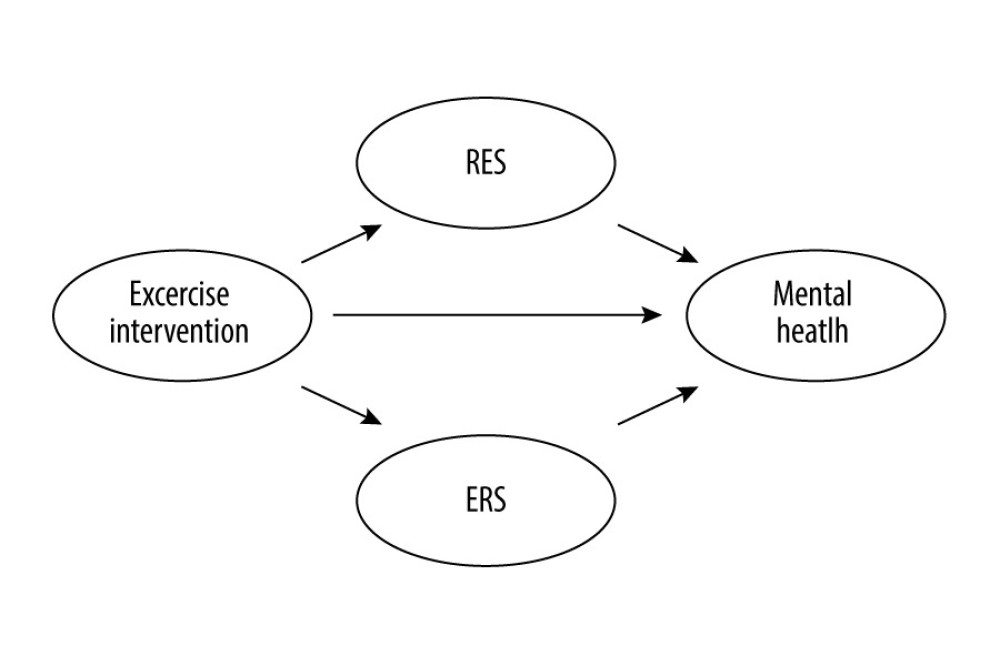 Figure 1. Hypothetical model of intrinsic relationship between physical exercise and mental health. RES – Regulatory Emotional Self-Efficacy, ERS – Emotion Regulation Strategy.
Figure 1. Hypothetical model of intrinsic relationship between physical exercise and mental health. RES – Regulatory Emotional Self-Efficacy, ERS – Emotion Regulation Strategy. 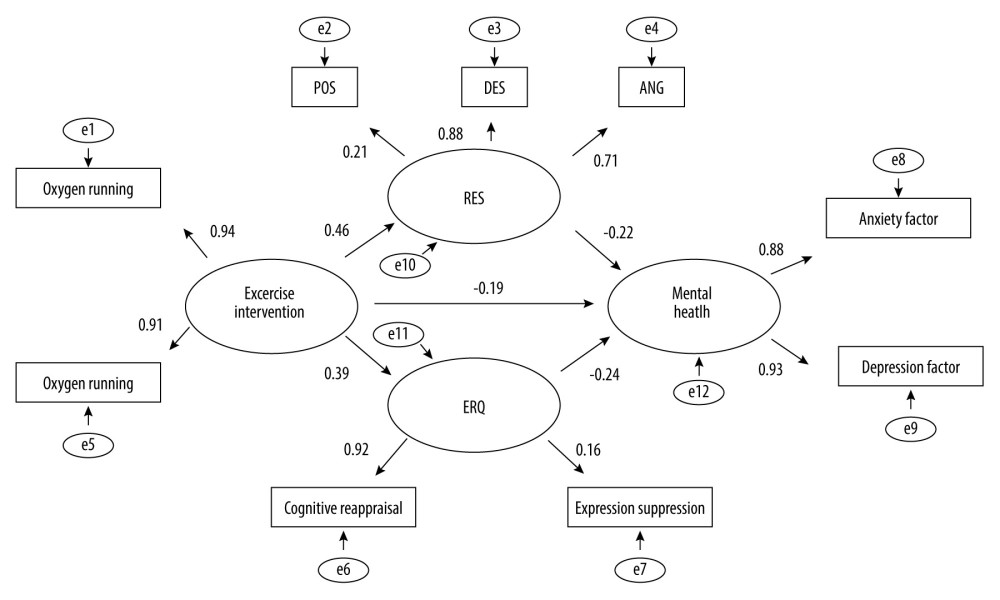 Figure 2. Model and model parameter normalization estimates of mental health. RES – Regulatory Emotional Self-Efficacy; POS – Expressing Positive Affect; DES – Managing Despondency/Distress; ANG – Managing Anger/Irritation; ERQ – Emotional Regulation Questionnaire.
Figure 2. Model and model parameter normalization estimates of mental health. RES – Regulatory Emotional Self-Efficacy; POS – Expressing Positive Affect; DES – Managing Despondency/Distress; ANG – Managing Anger/Irritation; ERQ – Emotional Regulation Questionnaire. References
1. Mcinman AD, Berger BG, Self-concept and mood changes associated with aerobic dance: Australian Journal of Psychology, 2011; 45(3); 134-40
2. Downs M, Strachan L, High school sport participation: Does it have an impact on the physical activity self-efficacy of adolescent males: International Journal of Human Movement and Sports Sciences, 2016; 4(1); 6-11
3. Lightsey OR, Maxwell DA, Nash TM, Self-control and self-efficacy for affect regulation as moderators of the negative affect – life satisfaction relationship: Journal of Cognitive Psychotherapy, 2011; 25(2); 142-54
4. Garnefski N, Kraaij V, Relationships between cognitive emotion regulation strategies and depressive symptoms: A comparative study of five specific samples: Personality & Individual Differences, 2006; 40(8); 1659-69
5. Han SS, Li B, Ke YZ, Chinese college students’ physical-exercise behavior, negative emotions, and their correlation during the COVID-19 outbreak: Int J Environ Res Public Health, 2022; 19(16); 10344
6. Sexton H, Maere A, Dahl NH, Exercise intensity and reduction in neurotic symptoms. A controlled follow-up study: Acta Psychiatr Scand, 1989; 80(3); 231-35
7. Petruzzello S, A meta-analysis on the anxiety reducing effects of acute and chronic exercise: Sports Med, 1991; 11(3); 143-82
8. Caprara GV, Di Giunta L, Eisenberg N, Assessing regulatory emotional self-efficacy in three countries: Psychol Assess, 2008; 20(3); 227-37
9. Li B, Han S, Meng S, Promoting exercise behavior and cardiorespiratory fitness among college students based on the motivation theory: BMC Public Health, 2022; 22(1); 738
10. Xue-Liu L, Mu X, The positive effect of perceived exercise benefit and the negative effect of perceived severity of disease and weakness on college students’ amount of exercise: The mediate and suppressor role of physical fitness evaluation self-efficacy: Front Psychol, 2021; 12; 762865
11. Gross JJ, John OP, Individual differences in two emotion regulation processes: Implications for affect, relationships, and well-being: J Pers Soc Psychol, 2003; 85(2); 348-62
12. Derogatis LR, Meyer JK, A psychological profile of the sexual dysfunctions: Arch Sex Behav, 1979; 8(3); 201-23
13. Hayden RM, Allen GJ, Relationship between aerobic exercise, anxiety, and depression: Convergent validation by knowledgeable informants: J Sports Med Phys Fitness, 1984; 24(1); 69-74
14. Shi RH: Shanghai Renmin Chubanshe, 1986; 139 [in Chinese]
15. Kurt K, 2010; 34-37, Beijing, Peking University Press [in Chinese]
16. Berger BG, Owen DR, Stress reduction and mood enhancement in four exercise modes: Swimming, body conditioning, hatha yoga, and fencing: Research Quarterly for Exercise and Sport, 1988; 59(2); 148-59
Figures
 Figure 1. Hypothetical model of intrinsic relationship between physical exercise and mental health. RES – Regulatory Emotional Self-Efficacy, ERS – Emotion Regulation Strategy.
Figure 1. Hypothetical model of intrinsic relationship between physical exercise and mental health. RES – Regulatory Emotional Self-Efficacy, ERS – Emotion Regulation Strategy. Figure 2. Model and model parameter normalization estimates of mental health. RES – Regulatory Emotional Self-Efficacy; POS – Expressing Positive Affect; DES – Managing Despondency/Distress; ANG – Managing Anger/Irritation; ERQ – Emotional Regulation Questionnaire.
Figure 2. Model and model parameter normalization estimates of mental health. RES – Regulatory Emotional Self-Efficacy; POS – Expressing Positive Affect; DES – Managing Despondency/Distress; ANG – Managing Anger/Irritation; ERQ – Emotional Regulation Questionnaire. Tables
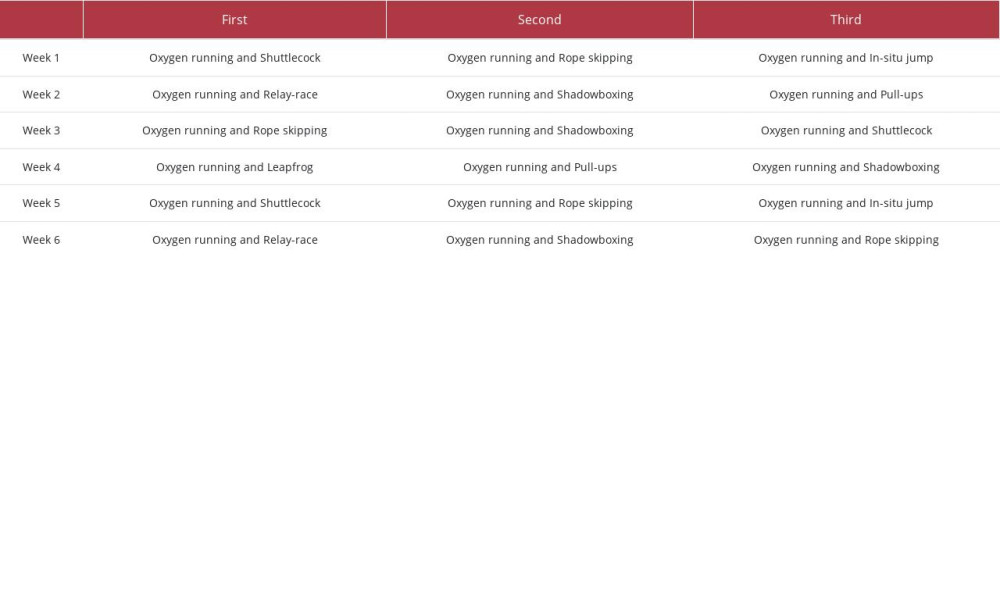 Table 1. Exercise ontervention plan for 6 weeks.
Table 1. Exercise ontervention plan for 6 weeks.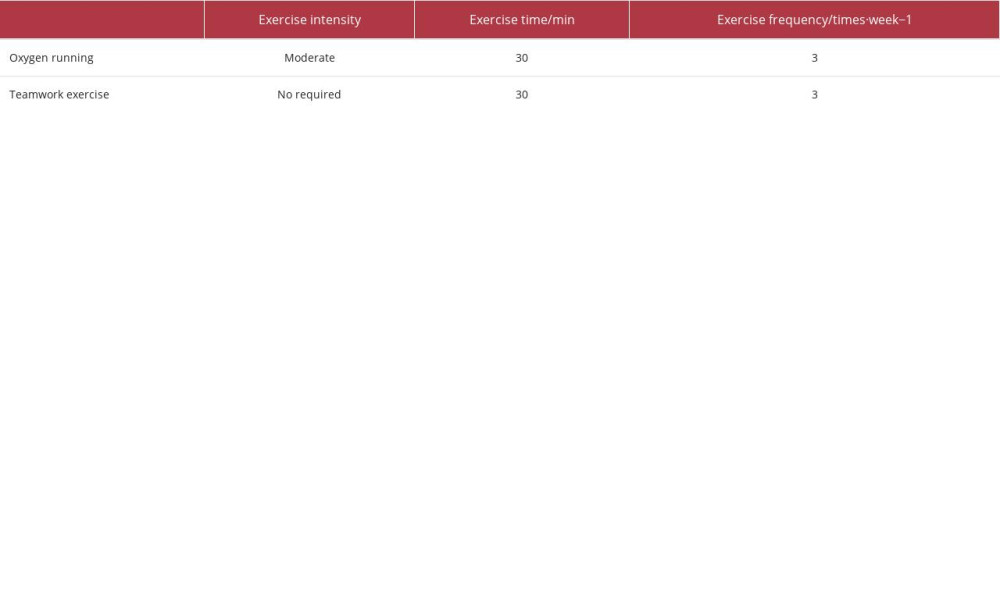 Table 2. The implementing scheme of exercise intervention.
Table 2. The implementing scheme of exercise intervention.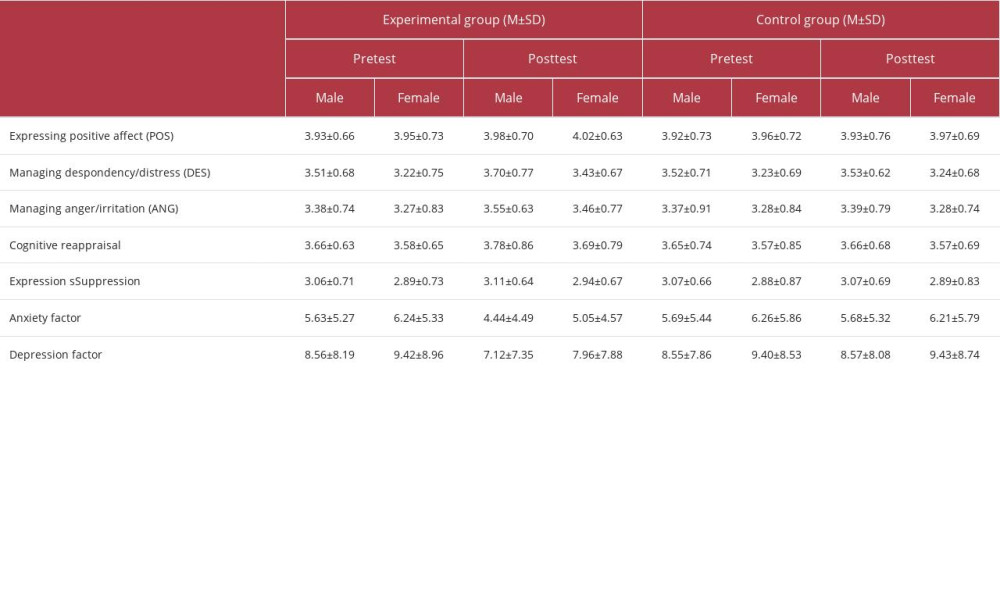 Table 3. Descriptive statistical analysis of variables before and after exercise intervention.
Table 3. Descriptive statistical analysis of variables before and after exercise intervention.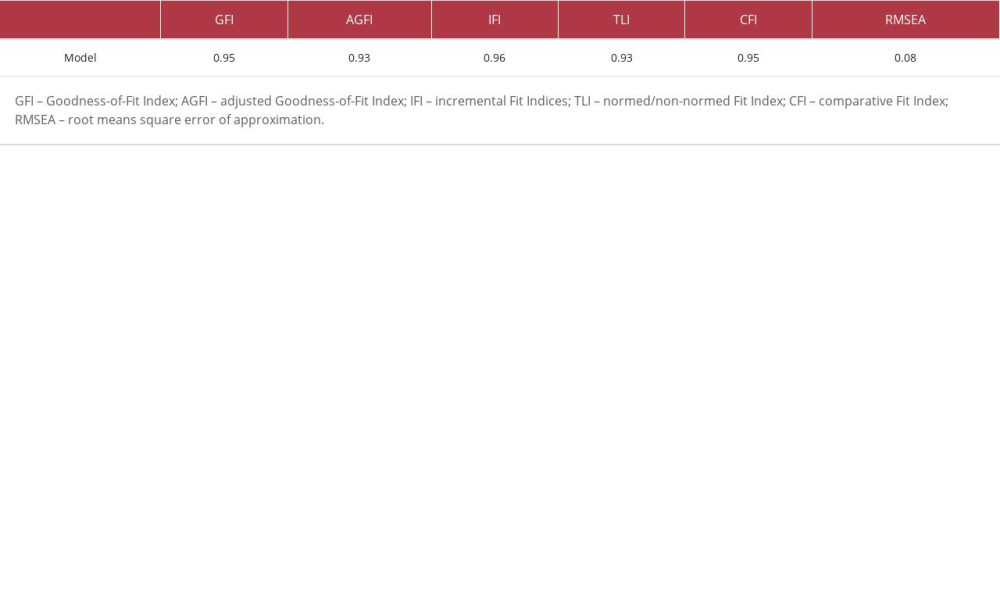 Table 4. Model fit test.
Table 4. Model fit test. Table 1. Exercise ontervention plan for 6 weeks.
Table 1. Exercise ontervention plan for 6 weeks. Table 2. The implementing scheme of exercise intervention.
Table 2. The implementing scheme of exercise intervention. Table 3. Descriptive statistical analysis of variables before and after exercise intervention.
Table 3. Descriptive statistical analysis of variables before and after exercise intervention. Table 4. Model fit test.
Table 4. Model fit test. Most Viewed Current Articles
15 Jun 2022 : Clinical Research
Evaluation of Apical Leakage After Root Canal Obturation with Glass Ionomer, Resin, and Zinc Oxide Eugenol ...DOI :10.12659/MSMBR.936675
Med Sci Monit Basic Res 2022; 28:e936675
07 Jul 2022 : Laboratory Research
Cytotoxicity, Apoptosis, Migration Inhibition, and Autophagy-Induced by Crude Ricin from Ricinus communis S...DOI :10.12659/MSMBR.936683
Med Sci Monit Basic Res 2022; 28:e936683
01 Jun 2022 : Laboratory Research
Comparison of Sealing Abilities Among Zinc Oxide Eugenol Root-Canal Filling Cement, Antibacterial Biocerami...DOI :10.12659/MSMBR.936319
Med Sci Monit Basic Res 2022; 28:e936319
08 Dec 2022 : Original article
Use of Estimated Glomerular Filtration Rate and Urine Albumin-to-Creatinine Ratio Based on KDIGO 2012 Guide...DOI :10.12659/MSMBR.938176
Med Sci Monit Basic Res 2022; 28:e938176








